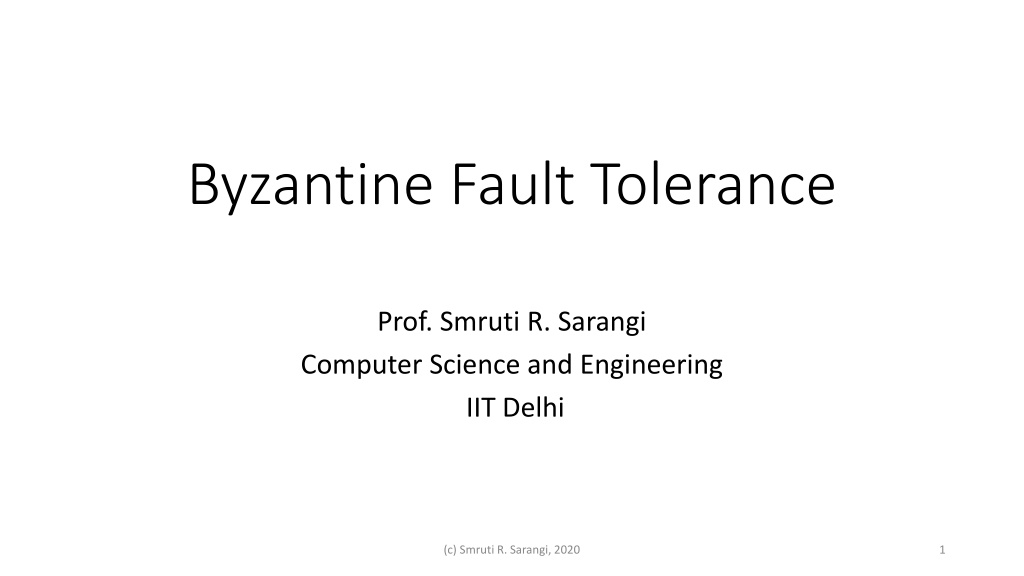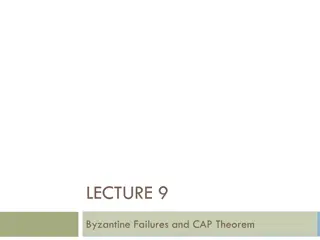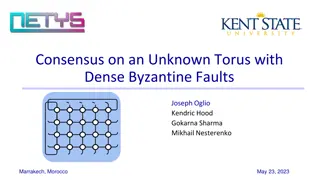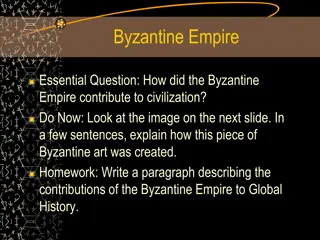Understanding Byzantine Fault Tolerance: A Comprehensive Overview
Byzantine Fault Tolerance (BFT) is a critical concept in computer science, addressing faults in distributed systems. This summary covers the types of faults (normal, crash, Byzantine), implications of Byzantine faults, Byzantine Generals Problem, impossibility results, and the complexity of solving such issues. The text also references the work of Prof. Smruti R. Sarangi from IIT Delhi.
- Byzantine Fault Tolerance
- Distributed Systems
- Byzantine Generals Problem
- Faulty Nodes
- Impossibility Results
Download Presentation

Please find below an Image/Link to download the presentation.
The content on the website is provided AS IS for your information and personal use only. It may not be sold, licensed, or shared on other websites without obtaining consent from the author. Download presentation by click this link. If you encounter any issues during the download, it is possible that the publisher has removed the file from their server.
E N D
Presentation Transcript
Byzantine Fault Tolerance Prof. Smruti R. Sarangi Computer Science and Engineering IIT Delhi (c) Smruti R. Sarangi, 2020 1
Byzantine Faults Normal faults Crash faults The process just stops Crash faults with intimation The process stops working and some entity lets other processes know. We have been dealing with such easy-to-manage faults up till now. Byzantine faults Everything is fair for nodes with Byzantine faults (lying, colluding, etc.) They can Show up as crash failures Fake and forge messages Even get together with other faulty nodes and create confusion (c) Smruti R. Sarangi, 2020 2
Byzantine Generals Problem Orders Commander General (c) Smruti R. Sarangi, 2020 3
Byzantine Generals Problem II The commander or any of the lieutenant generals can be disloyal Can have Byzantine failures. You cannot trust them at all. Consider a synchronous algorithm. The commander sends an order to n-1 lieutenant generals. Condition IC1: All loyal lieutenant generals obey the same order. Condition IC2: If the commander is loyal, every loyal general obeys the order that the commander issues. (c) Smruti R. Sarangi, 2020 4
Impossibility Results (c) Smruti R. Sarangi, 2020 5
Impossibility result for 3 generals. Assume 1 commander and 2 lieutenant generals. Assume at the most one Byzantine failure at the most one general (including the commander) is disloyal. No solution is possible. Traitor Commander Commander Retreat Attack Attack Attack General 1 General 2 General 1 General 2 Retreat [Commander said] Retreat [Commander said] No way to distinguish between these scenarios. General 1 chooses Attack (IC2). Similar argument can be used to prove that General 2 chooses RETREAT, when both are loyal. 6
General Result Assume there are m traitors and <= 3m generals No solution is possible Approach Let these generals be Albanian generals We will prove that if Albanian generals can solve this problem, then 3 Byzantine generals can also solve this problem for 1 traitor The latter is impossible! Divide the set of Albanian generals into 3 groups, let each Byzantine general simulate m Albanian generals The Byzantine commander simulates the Albanian commander + at the most (m-1) Albanian generals Each of the rest of the Byzantine generals simulate at the most m Albanian generals Since at most 1 Byzantine general can be a traitor, at most m Albanian generals can be traitors (c) Smruti R. Sarangi, 2020 7
Contradiction We assume we have a solution to the Albanian Generals problem Means we have ensured IC1 and IC2 Simulation assumption: Byzantine general loyal IC1: This means that all loyal Albanian generals obey the same order The two Byzantine generals simulating them also obey the same order This ensures condition IC1 for the Byzantine generals as well If the Byzantine command is loyal, then the Albanian commander is loyal All the loyal Albanian generals obey this order (assumption) Their simulating Byzantine generals also obey the same order. (IC2) Means we have a solution for 3 Byzantine generals. This is impossible! Albanian general loyal (c) Smruti R. Sarangi, 2020 8
Byzantine Agreement Algorithm (c) Smruti R. Sarangi, 2020 9
Assumptions A1 Every message is delivered correctly. Message integrity is maintained. A2 The receiver of a message knows the identity of the sender. A3 The absence of a message can be detected. Majority A majority function (v1 vn) that returns the majority value. If the majority does not exist, return RETREAT. (c) Smruti R. Sarangi, 2020 10
Algorithm: Step 1 OM(0) The commander sends its value to each lieutenant Each lieutenant accepts the value or accepts RETREAT if no message was sent. Commander Just accept the value General 2 General 1 General n (c) Smruti R. Sarangi, 2020 11
Step 2 OM(m), m > 0, total n generals including the commander The commander sends his value to every lieutenant Let lieutenant i, receive value vi from the commander. How does it know that the same value was sent to other lieutenants? It acts as a commander in an algorithm with the rest of the n-2 lieutenants OM(m-1): Sends them value vi, and tries to arrive at an agreement The loyal generals in OM(m-1)come to an agreement about the value received by lieutenant i It does not matter if lieutenant i is loyal or not. The rest of the loyal generals agree on the value that i got from its commander after OM(m-1). (n-1) lieutenants run their instance of OM(m-1) (c) Smruti R. Sarangi, 2020 12
Step 2: Visualization Commander 1. Don t accept the value that the commander sends General 2 General 1 General n OM(m-1) 2. Ask the rest of the lieutenants and come to an agreement regarding the value sent by the commander (c) Smruti R. Sarangi, 2020 13
Step 3: In step OM(m-1) general i receives a total of (n-1) values From (n-2) lieutenant generals (result of their OM(m-1) after Byzantine agreement) One value from its commander It computes the majority of the (n-1) values (= v) It uses this value v as the output of OM(m) This is a recursive algorithm Since generals don t trust their commander, they do not accept an order at face value. They inquire with the rest of the generals, and ask them what they have gotten. Each general collects (n-2) responses from other lieutenants, and 1 from its commander. It can be proven that all loyal generals will compute the same majority value subsequently. Notes 14 (c) Smruti R. Sarangi, 2020
Example: General 3 is the traitor Commander v v v General 1 General 2 General 3 v x General 1 and General 2 compute majority (v,v,x) = v (c) Smruti R. Sarangi, 2020 15
Example: Commander is the traitor Commander x y z General 1 General 2 General 3 z x y y x z Each general computes the same value: majority (x,y,z) (c) Smruti R. Sarangi, 2020 16
Proof (c) Smruti R. Sarangi, 2020 17
Lemma 1 For any m and k, OM(m) satisfies IC2 if there are more than 2k+m generals and at most k traitors. Let n = #generals. n > 2k + m Proof Assumption: commander is loyal. It broadcasts value v. For (m=0), this is trivially satisfied. Assume it is true for (m-1), prove it is true for m (use induction) Step 1: Commander sends a value to (n-1) lieutenants Step 2: Each loyal lieutenant applies OM(m-1) with (n-1) generals n > 2k + m (n-1) > 2k + (m-1) [OM(m-1) runs correctly] In OM(m-1) if a loyal lieutenant is a commander all other loyal lieutenants agree on v Since (m >=1), (n-1) > 2k. Thus a majority of lieutenants are loyal A loyal lieutenant i receives v from every loyal lieutenant j in OM (m-1) [assumption] Out of the (n-1) generals participating in each instance of OM(m-1), majority receive v Thus all loyal generals decide v (IC2). 18 (c) Smruti R. Sarangi, 2020
Theorem 1 With at most m traitors, and with more than 3m generals, OM(m) satisfies conditions IC1 and IC2. Proof If (m= 0), this is trivially true Assume it is true for OM(m-1), prove for OM(m) Assume the commander is loyal Take (k = m), and use Lemma 1 to prove that OM(m) satisfies IC2 It trivially satisfies IC1 Commander is not loyal At most (m-1) lieutenants are traitors OM(m-1) runs on more than (3m -1) generals 3m -1 > 3 (m-1). Induction hypothesis can be applied to OM(m-1) All instances of OM(m-1) thus satisfy both IC1 and IC2 (c) Smruti R. Sarangi, 2020 19
Proof - II This means that in Step 3, any two loyal lieutenants get the same values for each instance of OM(m-1) If the vector of values is (v1, vn-1), then all loyal lieutenants get the same vector They compute the same majority value. We thus have an agreement. With m traitors, we need at least (3m+1) generals. (c) Smruti R. Sarangi, 2020 20
Solution with Signed Messages (c) Smruti R. Sarangi, 2020 21
New assumptions Let us add the notion of signed messages This will be useful when we discuss cryptocurrencies Assumption A4: A loyal general s signature cannot be forged. Any alteration can be detected. Anybody can verify the authenticity of a general s signature. If we have m traitors, we can have a solution for any number of generals Let the commander be General 0. The notation x:i means the value x is signed by general i The notation x:i:j means that first i signed the message and then j Signatures are always appended (c) Smruti R. Sarangi, 2020 22
Assumptions - II Let the set Vi be the set of properly signed orders received by process i Initially Vi = . Assume a maximum of m traitors. Assume a function: choice(V). V is a set of values. If V contains a single element, v : choice(V) = v choice( ) = <default_value> choice(V) is fixed for a given V. It does not depend upon the order of elements within V. (c) Smruti R. Sarangi, 2020 23
Algorithm [0]The commander signs an order and sends it to every lieutenant For each lieutenant i If he receives a message of the form v:0 and has not received any order Vi = {v} [1]Sends the message v:0:i to every other lieutenant Lietuenant i receives a message of the form v:0:j1: :jkand ? ?? [2a] Add v to Vi [2b] If (k < m) sends (v:0:j1: :jk:i) to every lieutenant other than (j1 jk) [2c] If lieutenant i is not sending a message, it sends a message to everybody telling them that it will not send a message. This can be detected via a timeout as well. [3]When lieutenant i will get no more messages, it chooses choice(Vi) (c) Smruti R. Sarangi, 2020 24
Clarification How will a lieutenant know that it will not get any more messages? In round k every lieutenant gets a message with k signatures. The lack of a message can be detected. By the end of round k every loyal lieutenant is sure that it has seen all the messages with k signatures We will have at most m rounds (needs to be proven) Thus the algorithm will terminate. (c) Smruti R. Sarangi, 2020 25
Proof IC2: If the commander is loyal, he will send v:0 to every lieutenant. Since v cannot be forged, all the lieutenants will get v. They will only pass v. Thus Vi will only have a single element, v. IC1: commander is a traitor We need to prove that for two loyal lieutenants: Vi = Vj Consider an element ? ?? When i added v: Either this is the first message (round 0). Then i sends v to j. If not, then i must have gotten the message: v:0:j1:j2 . : jk If j is one of (j1 k), it must have already gotten an order with v. This means, ? ?? If j is not one of them, then i sends the order to j (step 2b) The only case we need to consider is when (k=m), and ? ?? (c) Smruti R. Sarangi, 2020 26
Proof - II Since k = m, and the commander is a traitor. At most (m-1) lieutenants are traitors. This means one lieutenant out of j1 jkis loyal Let it be jx jxmust have sent v to j. This proves that: If ? ??then ? ?? Second, m rounds are sufficient. (c) Smruti R. Sarangi, 2020 27
References 1. Lamport, Leslie, Robert Shostak, and Marshall Pease. "The Byzantine generals problem." Concurrency: the Works of Leslie Lamport. 2019. 203-226. (c) Smruti R. Sarangi, 2020 28
Thank you (c) Smruti R. Sarangi, 2020 29























